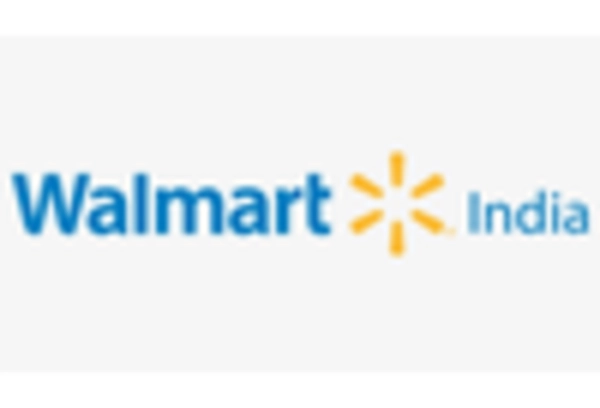Growing Middle Class Population
The expanding middle class in India is a pivotal driver for the India Apparel Market. With an estimated 300 million individuals expected to enter the middle class by 2030, there is a notable increase in disposable income. This demographic shift is likely to enhance consumer spending on apparel, as individuals seek to express their identity through fashion. The India Apparel Market is poised to benefit from this trend, as the demand for both traditional and contemporary clothing styles rises. Furthermore, the increasing urbanization, which is projected to reach 600 million by 2031, further fuels the need for diverse apparel options, catering to a more fashion-conscious consumer base.
Technological Advancements in Retail
Technological innovations are transforming the retail landscape, significantly impacting the India Apparel Market. The integration of artificial intelligence and machine learning in inventory management and customer service is enhancing operational efficiency. Additionally, the rise of augmented reality in virtual fitting rooms is reshaping the shopping experience, allowing consumers to visualize how apparel fits before making a purchase. As of 2025, the online apparel segment is expected to account for over 30% of total sales, indicating a shift towards digital platforms. This technological evolution not only streamlines the purchasing process but also attracts a younger demographic that values convenience and innovation.
Cultural Diversity and Fashion Trends
India's rich cultural diversity plays a crucial role in shaping the India Apparel Market. With over 2,000 distinct ethnic groups, the demand for varied apparel styles is substantial. Traditional garments such as sarees and lehengas coexist with modern fashion trends, creating a unique market dynamic. The fusion of traditional and contemporary styles is increasingly popular, appealing to both domestic and international consumers. As of 2025, the ethnic wear segment is projected to grow at a rate of 12% annually, reflecting the ongoing appreciation for cultural heritage in fashion. This diversity not only enriches the apparel offerings but also enhances the market's resilience against global fashion trends.
Rising Awareness of Sustainable Fashion
The growing awareness of sustainability among consumers is significantly influencing the India Apparel Market. As environmental concerns become more pronounced, there is a marked shift towards eco-friendly materials and ethical production practices. Brands that prioritize sustainability are likely to attract a conscientious consumer base, particularly among millennials and Gen Z. The market for sustainable apparel is projected to grow by 20% annually, indicating a robust demand for environmentally responsible fashion. This trend encourages brands to innovate in their sourcing and manufacturing processes, ultimately contributing to a more sustainable apparel ecosystem in India.
Influence of Celebrity Endorsements and Fashion Influencers
The impact of celebrity endorsements and fashion influencers is a notable driver in the India Apparel Market. As social media platforms proliferate, the reach of influencers has expanded, shaping consumer preferences and purchasing decisions. Collaborations between brands and popular figures often lead to increased visibility and desirability of apparel lines. In 2025, it is estimated that influencer marketing will account for over 15% of total marketing budgets in the fashion sector. This trend not only boosts brand awareness but also fosters a sense of community among consumers, as they seek to emulate the styles of their favorite personalities.


















Leave a Comment